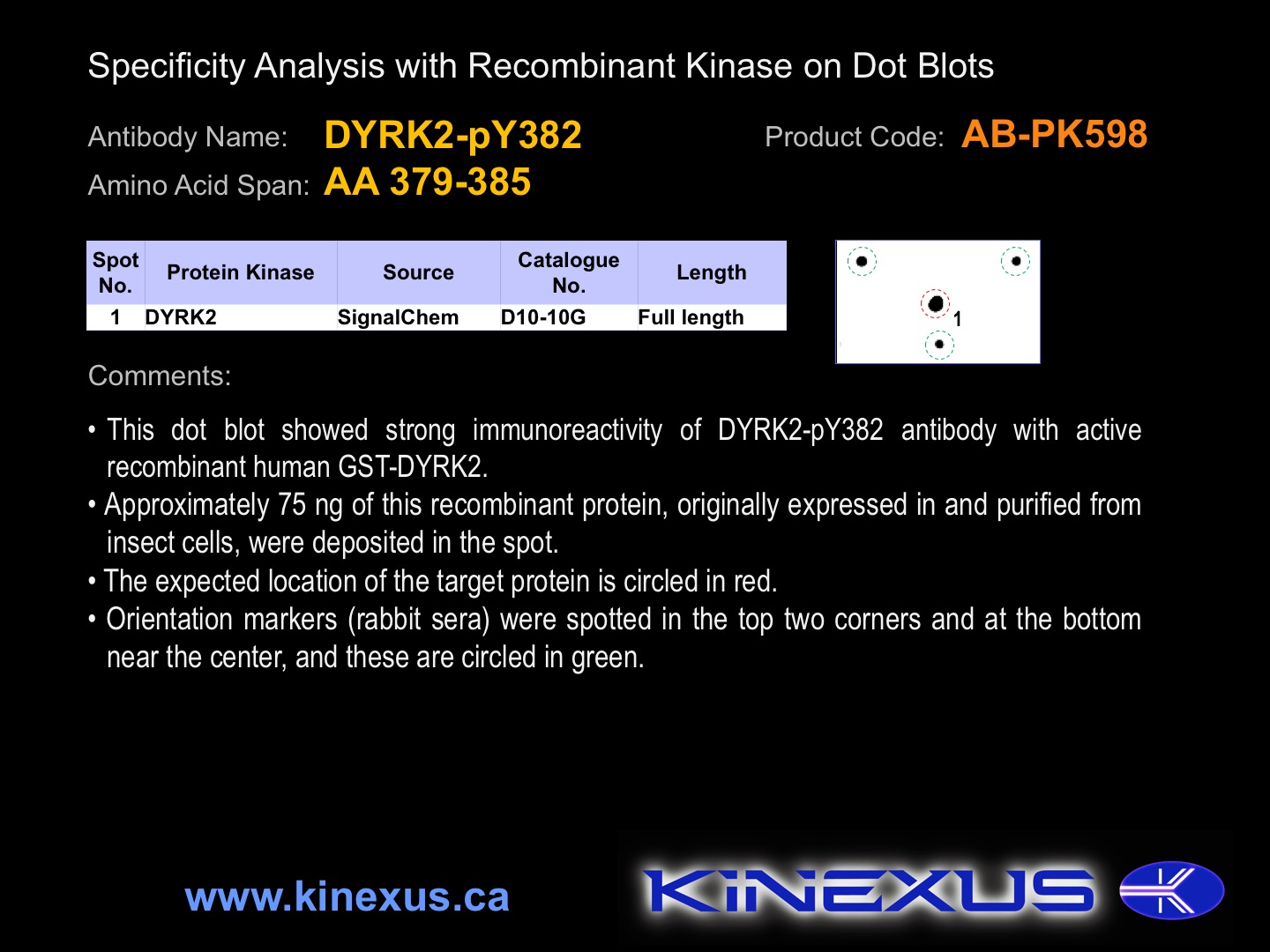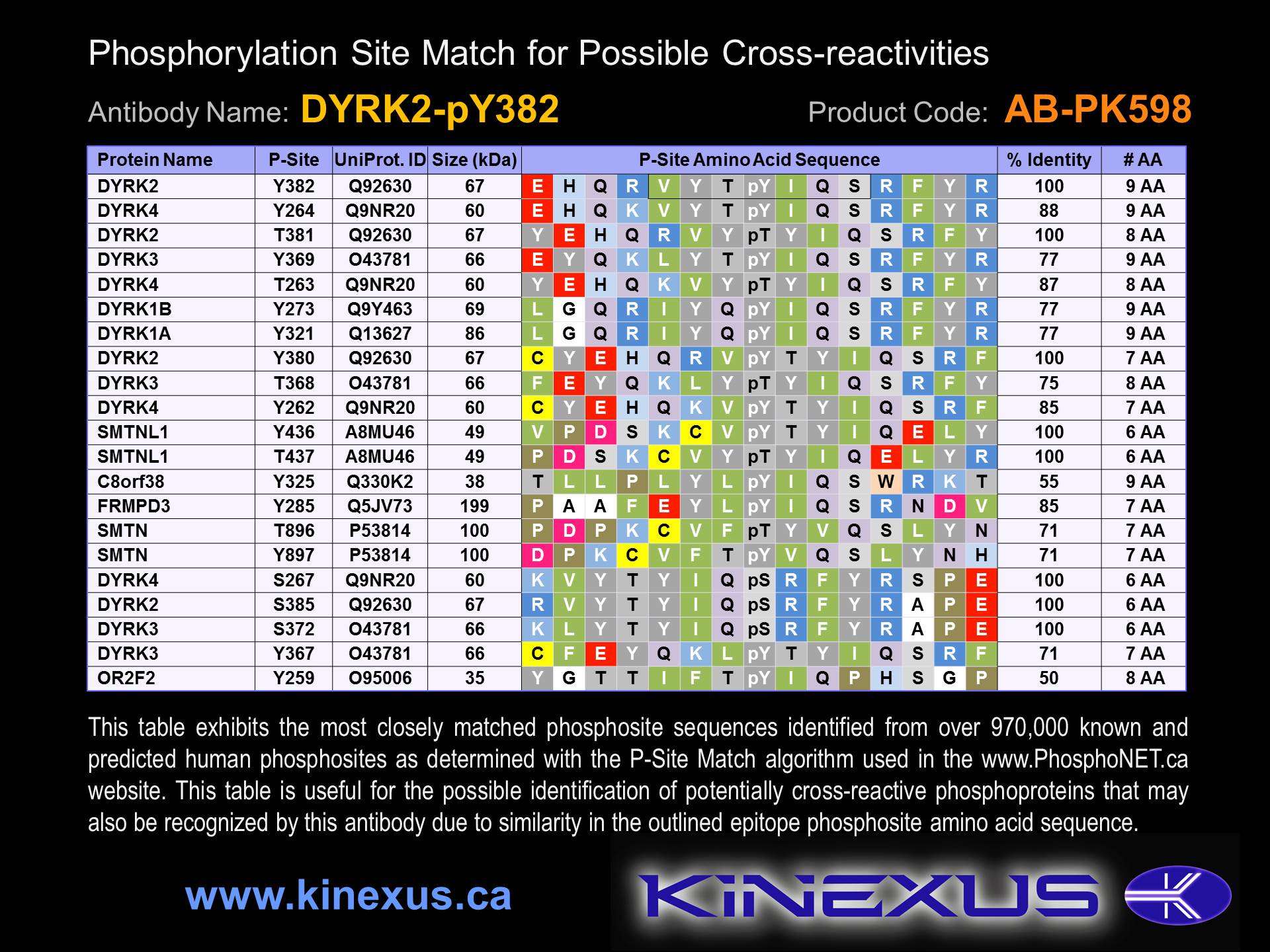Product Name: DYRK2-pY382
Product Number: AB-PK598
| Size: | 25 µg | Price: | 89.00 | |
| $US |
Target Full Name: Dual specificity tyrosine-phosphorylation-regulated kinase 2
Target Alias: Dual-specificity tyrosine-(Y)-phosphorylation regulated kinase 2; DYRK2; FLJ21217; FLJ21365
Product Type Specific: Protein kinase phosphosite-specific antibody
Antibody Code: PK598
Antibody Target Type: Phosphosite-specific
Antibody Phosphosite: Y382
Protein UniProt: Q92630
Protein SigNET: Q92630
Antibody Type: Polyclonal
Antibody Host Species: Rabbit
Antibody Immunogen Source: Human DYRK2 sequence peptide
Target Alias: Dual-specificity tyrosine-(Y)-phosphorylation regulated kinase 2; DYRK2; FLJ21217; FLJ21365
Product Type Specific: Protein kinase phosphosite-specific antibody
Antibody Code: PK598
Antibody Target Type: Phosphosite-specific
Antibody Phosphosite: Y382
Protein UniProt: Q92630
Protein SigNET: Q92630
Antibody Type: Polyclonal
Antibody Host Species: Rabbit
Antibody Immunogen Source: Human DYRK2 sequence peptide
Antibody Immunogen Sequence: VYT(pY)IQS(bA)C
Antibody Immunogen Description: Corresponds to amino acid residues V379 to S385; In the protein kinase catalytic domain activation T loop region between subdomains VII and VIII.
Antibody Immunogen Description: Corresponds to amino acid residues V379 to S385; In the protein kinase catalytic domain activation T loop region between subdomains VII and VIII.
Production Method: The immunizing peptide was produced by solid phase synthesis on a multipep peptide synthesizer and purified by reverse-phase hplc chromatography. Purity was assessed by analytical hplc and the amino acid sequence confirmed by mass spectrometry analysis. This peptide was coupled to KLH prior to immunization into rabbits. New Zealand White rabbits were subcutaneously injected with KLH-coupled immunizing peptide every 4 weeks for 4 months. The sera from these animals was applied onto an agarose column to which the immunogen peptide was thio-linked. Antibody was eluted from the column with 0.1 M glycine, pH 2.5. Subsequently, the antibody solution was neutralized to pH 7.0 with saturated Tris.This antibody was also subject to negative purification over phosphotyrosine-agarose.
Antibody Modification: Unconjugated. Contact KInexus if you are interest in having the antibody biotinylated or coupled with fluorescent dyes.
Antibody Modification: Unconjugated. Contact KInexus if you are interest in having the antibody biotinylated or coupled with fluorescent dyes.
Antibody Concentration: 0.3 mg/ml
Storage Buffer: Phosphate buffered saline pH 7.4, 0.05% Thimerasol
Storage Conditions: For long term storage, keep frozen at -40°C or lower. Stock solution can be kept at +4°C for more than 3 months. Avoid repeated freeze-thaw cycles.
Product Use: Western blotting | Antibody microarray
Antibody Dilution Recommended: 2 µg/ml for immunoblotting
Antibody Species Reactivity: Human
Antibody Positive Control: The observed molecular mass of the processed target protein on SDS-PAGE gels is reported to be around 60-70 kDa.
Antibody Specificity: Very high
Storage Buffer: Phosphate buffered saline pH 7.4, 0.05% Thimerasol
Storage Conditions: For long term storage, keep frozen at -40°C or lower. Stock solution can be kept at +4°C for more than 3 months. Avoid repeated freeze-thaw cycles.
Product Use: Western blotting | Antibody microarray
Antibody Dilution Recommended: 2 µg/ml for immunoblotting
Antibody Species Reactivity: Human
Antibody Positive Control: The observed molecular mass of the processed target protein on SDS-PAGE gels is reported to be around 60-70 kDa.
Antibody Specificity: Very high
Antibody Cross Reactivity: No significant cross-reactive proteins detected in HeLa, A431 and MCF7 cells.
Related Product 1: DYRK2-ANT pan-specific antibody (Cat. No.: AB-NK266-1)
Related Product 2: DYRKSubtide - DYRK1A protein kinase substrate peptide
Related Product 1: DYRK2-ANT pan-specific antibody (Cat. No.: AB-NK266-1)
Related Product 2: DYRKSubtide - DYRK1A protein kinase substrate peptide
Scientific Background: DYRK2 is a protein-serine/threonine kinase of the CMGC group and DYRK family. It is a dual-specificity protein kinase that regulates cell cycle progression, cell proliferation, apoptosis, cytoskeletal organization, and neurite outgrowth. DYRK2 functions downstream of ATM and directly phosphorylates p53/T53 at the S46 to promotion of apoptosis in the presence of DNA damage. In addition, DYRK2 functions in ubiquitin-dependent proteasomal protein degradation, specifically promoting the degradation of the oncoproteins in the Myc and Jun families. DYRK2 appears to be a tumour suppressor protein (TSP). Abnormal expression of DYRK2 have been associated with various forms of human cancer. In breast cancer cells, DYRK2 negatively regulates the stability of Snail, a transcription factor that regulates the epithelial-mesenchymal transistion (EMT). Knock-down of DYRK2 expression in breast cancer cells promotes EMT and tumour invasion both in vitro and in vivo. In addition, tumours with low expression of DYRK2 were correlated with a significantly lower patient survival and higher metastasis rate than tumours with high DYRK2 expression. Therefore, the DYRK2 protein appears to be a critical suppressor of cancer invasion and metastasis. Similarly, the 5-year survival rates of pulmonary adenocarcinoma patients was significant higher for those with DYRK2-positive tumours (89. 2%) than those with DYRK2-negative tumours (66. 3%), indicating a critical role for DYRK2 as a tumour suppressor in this cancer type as well.
Figure 1. Dot blotting DYRK2-pY382 antibody with recombinant purified proteins.
Figure 2. Identification of phosphosites related to DYRK2-pY382.
© Kinexus Bioinformatics Corporation 2017



